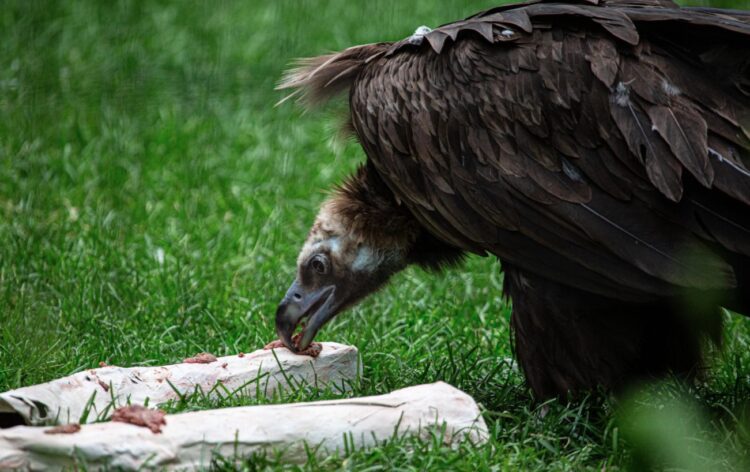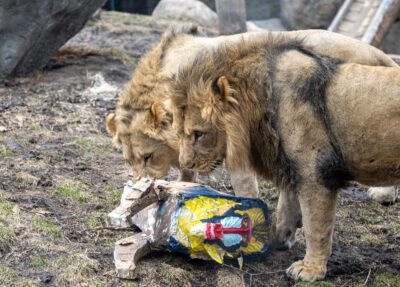Exceptional animal care starts with making sure basic physical needs are met for the more than 700 individuals here at Lincoln Park Zoo—like food. Feeding the animals is a vital job. It’s a big and costly one, too, making up the highest budget here. Every day, this task requires taking into account the needs of herbivores, carnivores, insectivores, and animals with specialized diets based on their ecology, behavior, age, sex, body condition, and personal idiosyncrasies.
Fortunately, the Nutrition Center at the zoo is up to the task. Feeding the animals at the zoo requires a partnership between Nutrition staff, veterinary staff, and keepers who work with the animals each day. This is a job that involves it all — science, heavy labor, plenty of moving parts, and a whole lot of experimentation. In this job, you have to be flexible.
After all, animals are living beings with their own preferences and biases. To begin with, some species are naturally choosy: red pandas eat mostly bamboo in the wild and Canada lynx stick with snowshoe hares when they can. Others go into torpor in the winter (think black bears) and thus require a higher caloric intake at certain times of year. Some species may actually prefer foods that don’t have a whole lot of appropriate vitamin and mineral content, so they need to be fortified.
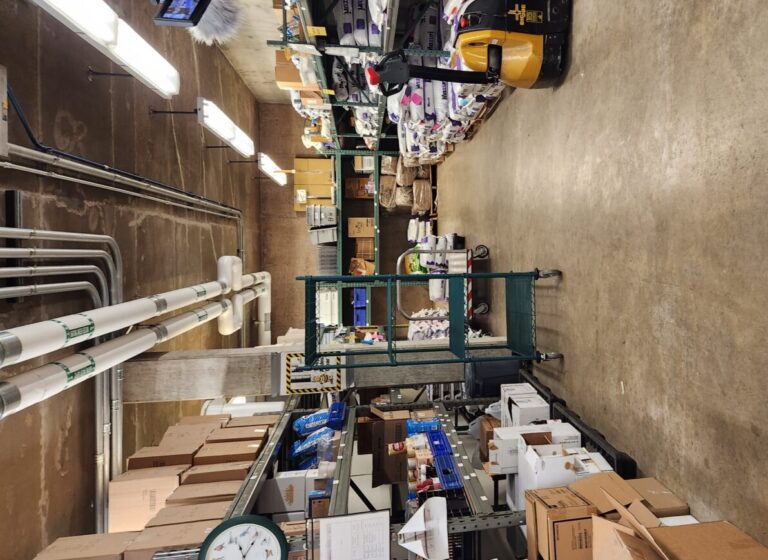
Behind the scenes at the Nutrition Center
“I can calculate the best diet in the world for animals in our care, but if they don’t eat it all, that’s for naught,” says Siga Lapinskas, Nutrition Center Manager at Lincoln Park Zoo. “Diet formulation only takes us to a certain point. Because animals are individuals, we have to be flexible in adapting and reformulating to make sure their nutritional needs are met based on their preferences.”
She points specifically to the gorilla troops at Regenstein Center for African Apes; each of these primates definitely has their own preferences. Other challenging animals include picky polar bears with allergies and older, geriatric animals whose needs change as they age.
Formulating Diets Backed by Data
The Nutrition Center focuses on higher-level concerns such as formulating optimal diets and doing continual research to make sure the animals are receiving all the vitamins, minerals, and other beneficial nutrients they need.
Now, this isn’t as easy as feeding your dogs and cats at home. With many animals, such as certain reptiles and birds, there isn’t enough information about their specific species to simply look up appropriate foods and use manufacturer instructions to determine how much to provide.
That means nutritionists at zoos are comparative nutritionists. They are experts at taking diets that have been created for domestic or more familiar animals—horses, for example—and extrapolating to wild counterparts such as zebras. Or, alternatively, taking a wild diet for a species—polar bears who eat seals, for example—and finding a suitable alternative.
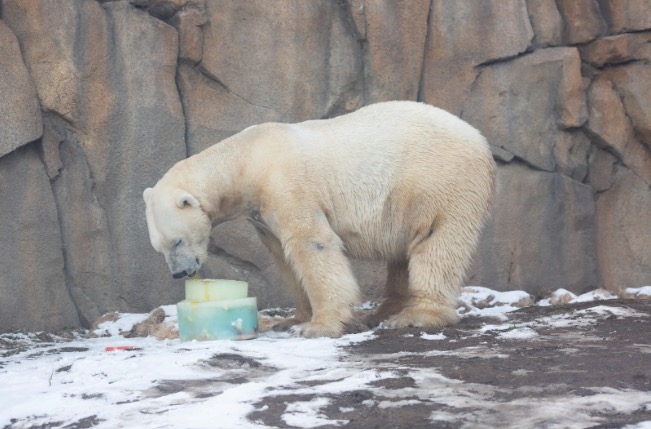
Polar bear with icy enrichment
Staff members use guidelines provided by the Association of Zoos and Aquariums, the Nutrition Research Council, and peer-reviewed scientific journal articles to formulate diets. The Nutrition team hopes to also incorporate behavioral data to help improve diets and diet presentation.
However, the duties of Nutrition Center staff also include logistical tasks, such as ordering and receiving food items and dealing with vendors. Lapinskas says that about 95 percent of her job involves sitting at a computer formulating diets, answering emails, researching products, checking nutrient recommendations, and working on logistics.
Food Storage and Daily Operations
In many ways, the Nutrition Center’s storage area on the north end of the zoo serves as a central receiving area. This is where zoo uniforms and bedding, supplies for animal enrichment, and food for all the animals are stored.
In 2023, the center received two brand new coolers and a freezer that help keep different categories of foodstuffs separate. One is reserved just for produce.
Here, you’ll find everything from frozen produce to homemade baby food and homemade jams and jellies (which are made without added sugar). This space stores packages of commercial diets (think dog or cat food you can purchase yourself), bubble bath for Regenstein Center for African Apes and Pepper Family Wildlife Center, mustard and ketchup for primate enrichment (they get placed in termite mounds), gelatin for the seals, juice that helps medicine go down more easily, and peanut butter—which is universally loved by zoo animals.
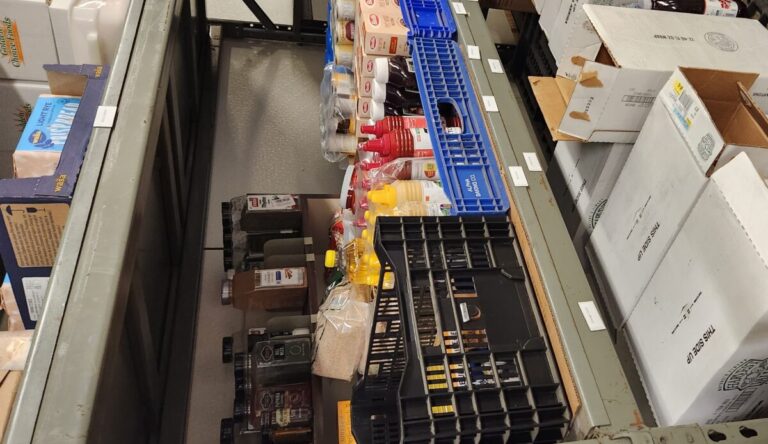
Some of the food items being stored at the Nutrition Center
“You can get almost any animal to do anything with peanut butter,” Lapinskas says. Although keepers say that Cosie the pygmy slow loris is the exception.
The four staff members on the Nutrition team are responsible for storing, processing, safety and other tasks. They use color-coded sets of tools, designed to ensure there’s no cross-contamination between animal proteins and produce. Each day begins with several runs’ worth of food deliveries to animal areas using the zoo’s first electric van, which are done by the time the zoo opens in the morning, along with food preparation and the making of jams, gelatins, and other prepared foods.
Working With Keepers
Nutrition Center staff work in tandem with Animal Care staff to make sure animals get the diets they need. To start with, Lapinskas and her crew work with curators, managers, and lead keepers to formulate diets suitable for each individual animal. This often involves balancing the needs and the wants of animals, making sure they get the right nutrients but also taking their preferences into account. “We have a lot of conversations beforehand, talking with the team to see what they need,” Lapinskas says.
The keepers, who know the individual animals well, handle the actual feeding duties on a daily basis. They’re the ones who know the animals and their personalities, so they are an important part of the process. Many of the animal buildings have their own kitchens, which keepers will use to customize diets on-site.
And if there are any issues, keepers are the first to know if problems arise and what solutions might work. “It’s a common misconception that animals know what’s good for them and that they can self-regulate,” Lapinskas says. “We get pretty creative with foods and the way we offer them.”
The cooperation between departments involves many aspects, including record-keeping of orders (through an app) and fortifying foods with vitamin supplements. For example, all the fish fed to zoo animals includes additional vitamins that are lost during the freezing process. Crickets for insectivores are kept in animal buildings, not at the Nutrition Center, and are fed a special diet to make sure the animals get sufficient quantities of calcium, vitamin A, and other nutrients.
For more on the process of getting these insects processed and out to the animals, visit our TikTok post on the subject:
It also involves incorporating enough high value food items, which can be used as rewards during positive reinforcement training. These foods need to be balanced within the diet, so nutrition isn’t compromised but they still motivate animals to participate in their own healthcare and other activities that are beneficial for their wellbeing.
Animal Care staff are also in charge of animal welfare on a more holistic level, like monitoring individual body weight and instituting exercise regimens where needed. They also track any incidences in which animals may be eating items not fed to them by keepers (such as when lions catch birds wandering through their habitat). Basically, most of the on-the-ground care falls to keepers.
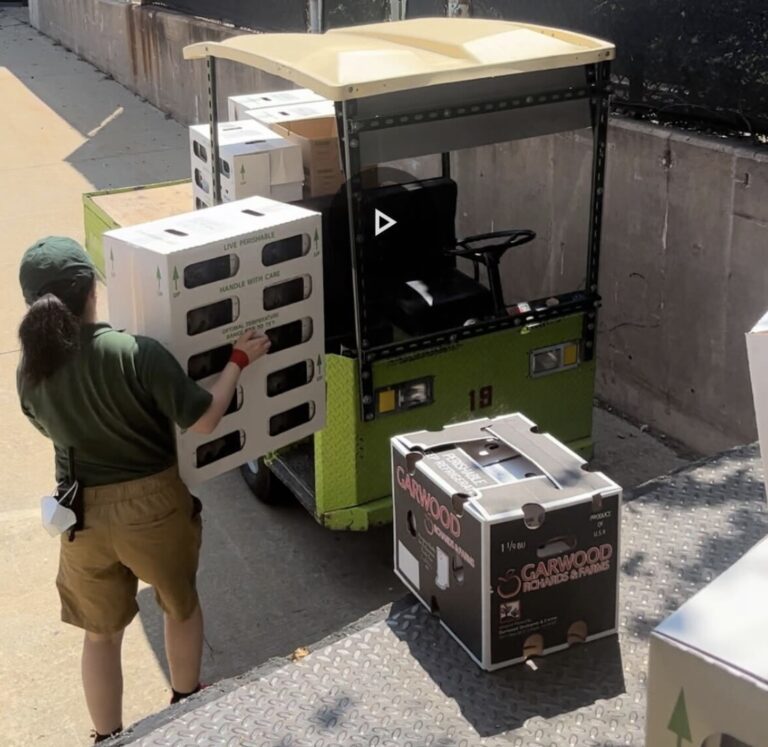
Moving Forward
Lincoln Park Zoo’s nutrition program is special because it is able to dedicate time and resources and bring on staff; the zoo doesn’t have to rely on nutrition consultants or get advice from other zoos. As a result, the Nutrition program continues to grow and evolve in ways specific to the needs of the animals that live here.
Physically, this involves improving the space, as with those new coolers and freezer. Technologically, it involves finding newer, more accurate ways to track supplies, diets, and more. On an organizational level, it involves centralizing operations so that the zoo is more efficient in how it distributes food and can better measure changes and meet keeper needs at the same time.
The future of the Nutrition Program at Lincoln Park Zoo will hopefully be bright. A core piece of that is working together with keepers, managers, and horticulture to improve the browse program. Browse (plant material such as leaves, twigs, and bark) is essential for many herbivores including giraffes, black rhinos, colobus, and gorillas. It helps not only with providing the proper nutrients, but also can have positive impacts on gut microbiomes.
“Our job is to improve the lives of animals in our care and nutrition plays a key role,” Lapinskas says. “The Nutrition Center Team is always thinking about how we can improve animal welfare as well as keeper welfare!”
